
关于数据集
有一家名为Happy Customer Bank (快乐客户银行) 的银行,是一家中型私人银行,经营各类银行产品,如储蓄账户、往来账户、投资产品、信贷产品等。
该银行还向现有客户交叉销售产品,为此他们使用不同类型的通信方式,如电话、电子邮件、网上银行推荐、手机银行等。
在这种情况下,Happy Customer Bank 希望向现有客户交叉销售其信用卡。该银行已经确定了一组有资格使用这些信用卡的客户。
银行希望确定对推荐的信用卡表现出更高意向的客户。
该数据集主要包括:
- 客户详细信息(gender, age, region, etc)
- 他/她与银行的关系详情(Channel_Code、Vintage、Avg_Asset_Value, etc)
在这里,我们的任务是构建一个能够识别对信用卡感兴趣的客户的模型。
导入库
导入必要的库,例如用于线性代数的 NumPy、用于数据处理的 Pandas、Seaborn 和用于数据可视化的 Matplotlib。
import numpy as np
import pandas as pd
import matplotlib.pyplot as plt
import seaborn as sns- 1.
- 2.
- 3.
- 4.
加载数据集
df_train=pd.read_csv("dataset/train_s3TEQDk.csv")
df_train["source"]="train"
df_test=pd.read_csv("dataset/test_mSzZ8RL.csv")
df_test["source"]="test"
df=pd.concat([df_train,df_test],
ignore_index=True)
df.head()- 1.
- 2.
- 3.
- 4.
- 5.
- 6.
- 7.

检查和清洗数据集
加载数据集后,下一步是检查有关数据集的信息并清理数据集,包括检查形状、数据类型、唯一值、缺失值和异常值等。
检查形状
df.shape- 1.
在我们的数据集中,合并训练和测试文件后,我们有 351037 行,具有 12 个特征。
检查唯一值
df.nunique()
ID 351037
Gender 2
Age 63
Region_Code 35
Occupation 4
Channel_Code 4
Vintage 66
Credit_Product 2
Avg_Account_Balance 162137
Is_Active 2
Is_Lead 2
source 2
dtype: int64- 1.
- 2.
- 3.
- 4.
- 5.
- 6.
- 7.
- 8.
- 9.
- 10.
- 11.
- 12.
- 13.
- 14.
检查缺失值
df.isnull().sum()
ID 0
Gender 0
Age 0
Region_Code 0
Occupation 0
Channel_Code 0
Vintage 0
Credit_Product 41847
Avg_Account_Balance 0
Is_Active 0
Is_Lead 105312
source 0- 1.
- 2.
- 3.
- 4.
- 5.
- 6.
- 7.
- 8.
- 9.
- 10.
- 11.
- 12.
- 13.
Credit_Product 特征中存在不少空值。
现在我们使用 fillna 方法来填充数据集中的空值。
#填充空值
df['Credit_Product']= df['Credit_Product'].fillna("NA")- 1.
- 2.
我们删除了数据集中存在的所有空值。
检查数据类型
接下来我们必须检查特征的数据类型。
df.info()
<class 'pandas.core.frame.DataFrame'>
RangeIndex: 351037 entries, 0 to 351036
Data columns (total 12 columns):
# Column Non-Null Count Dtype
--- ------ -------------- -----
0 ID 351037 non-null object
1 Gender 351037 non-null object
2 Age 351037 non-null int64
3 Region_Code 351037 non-null object
4 Occupation 351037 non-null object
5 Channel_Code 351037 non-null object
6 Vintage 351037 non-null int64
7 Credit_Product 351037 non-null object
8 Avg_Account_Balance 351037 non-null int64
9 Is_Active 351037 non-null object
10 Is_Lead 245725 non-null float64
11 source 351037 non-null object
dtypes: float64(1), int64(3), object(8)
memory usage: 32.1+ MB- 1.
- 2.
- 3.
- 4.
- 5.
- 6.
- 7.
- 8.
- 9.
- 10.
- 11.
- 12.
- 13.
- 14.
- 15.
- 16.
- 17.
- 18.
- 19.
- 20.
观察得到:
- 一些分类特征需要在数值数据类型中进行更改。
- 在这里,我们发现 Is_Active 特征有两个值,即 Yes 和 No。因此,我们必须将这些值转换为 float 数据类型。
将 Is_Active 列中的 Yes 更改为 1 并将 No 更改为 0 以将数据转换为浮点数。
df["Is_Active"].replace(["Yes","No"]
,[1,0], inplace=True)
df['Is_Active'] = df['Is_Active'].astype(float)
df.head()- 1.
- 2.
- 3.
- 4.

现在,为了将所有分类列更改为数字形式,我们使用标签编码。我们先简要了解标签编码到底是什么。
标签编码: 标签编码是指将标签转换为数字形式,以便将其转换为机器可读形式。它是一种用于处理分类变量的流行编码技术。
接下来使用标签编码器。
#创建分类列列表
cat_col=['Gender', 'Region_Code',
'Occupation','Channel_Code',
'Credit_Product']
from sklearn.preprocessing import LabelEncoder
le = LabelEncoder()
for col in cat_col:
df[col]= le.fit_transform(df[col])
df_2= df
df_2.head()- 1.
- 2.
- 3.
- 4.
- 5.
- 6.
- 7.
- 8.
- 9.
- 10.
- 11.
此时,我们可以删除不相关且对我们的数据集没有影响的特征。这里我们有两列要删除,即"ID"和"source"。让我们检查一下最新的输出。

至此,我们观察到所有数据都是数字。
数据可视化
为了更加清晰地分析数据集,数据可视化是一个不可或缺的步骤。
单变量分析
首先,我们绘制了 dist计数图 以了解数据的分布。
年龄特征分布密度图
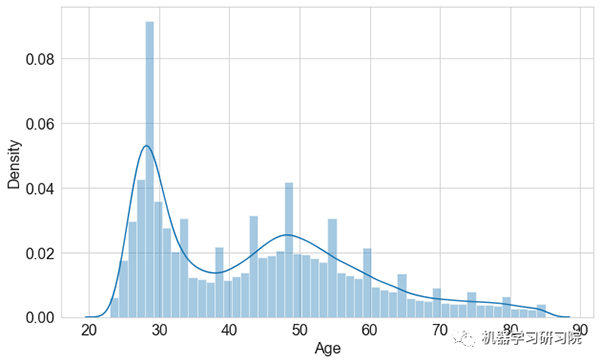
观察得到:
- 在年龄分布略偏向左侧,即“正偏态”。
- 在这里,我们看到一个峰值年龄组在 20 到 40 岁之间,该年龄段更加年轻,而另一个峰值年龄组在 40 到 60 岁之间。除此之外,40 到 60 岁之间的人更有优势。
- 因此,这可能与"Vintage"变量相关联,该变量对于较高年龄组更明显。
性别特征的计数图
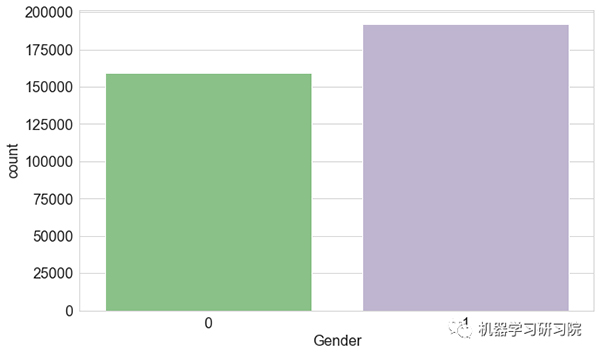
观察得到:
- 数据集中存在更多男性客户。但是,在决定谁拥有更好的决策权时,客户的性别并不重要。
目标变量计数图
本案例中的目标变量为 Is_Lead 特征。
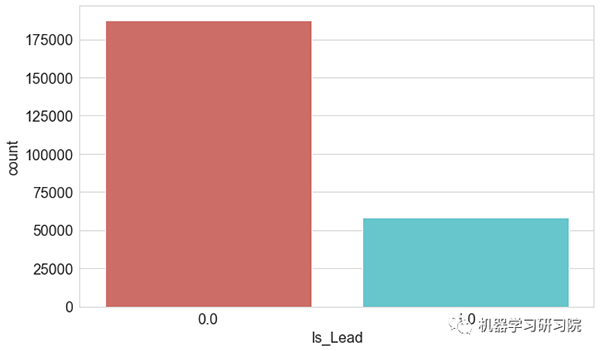
观察得到:
- 该图显示数据高度不平衡,在应用不同算法之前进行需要对数据集进行平衡处理。
- 为了平衡数据集,下面的步骤中将会使用欠采样技术。
此处可以参考:机器学习中样本不平衡,怎么办?
双变量分析
接下来做一些双变量分析,以理解不同列之间的关系。
"职业"和"客户"
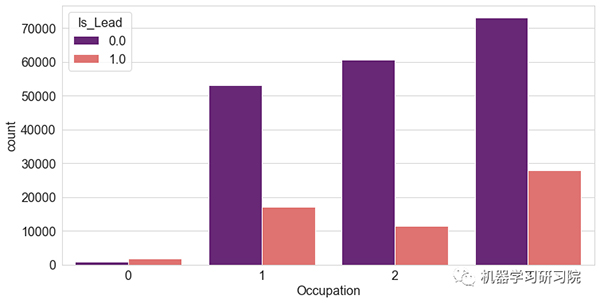
观察得到:
- 我们观察到自由职业客户不太可能办理信用卡。而企业家(尽管有限)最有可能办理信用卡。
近3个月内不同"客户的职业"的"客户活跃度"
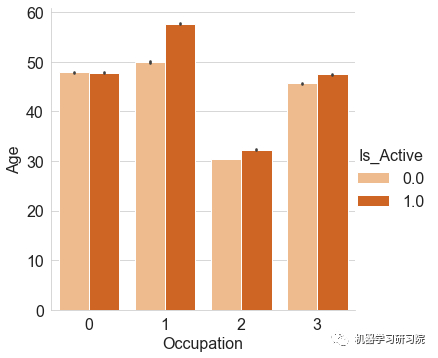
观察得到:
- 在过去3个月里,与企业家相比,活跃客户更多地来自工薪阶层、个体经营者和其他人群。
- 与 “活跃” 的客户相比,过去3个月内不活跃的客户相当多。
- 与 “非活跃” 客户相比,“活跃” 客户的潜在客户比例更高。
数据预处理
正如前所述,该数据集目标变量是不平衡的,需要进行平衡处理以建立有效的建模。
因此我们采用欠采样方法来处理平衡数据集。
接下来首先导入库,再将少数类和多数类分开。
from sklearn.utils import resample
# 将少数类和多数类分开
df_majority = df_1[df_1['Is_Lead']==0]
df_minority = df_1[df_1['Is_Lead']==1]
print("多数类值为", len(df_majority))
print("少数类值是", len(df_minority))
print("两个类的比例是", len(df_majority)/len(df_minority))- 1.
- 2.
- 3.
- 4.
- 5.
- 6.
- 7.
观察得到:
多数类值为187437,少数类值为58288,两个类的比率为3.2。
现在,需要将少数类与过采样的多数类结合起来。
# 欠采样多数类
df_majority_undersampled = resample(df_majority,
replace=True,
n_samples=len(df_minority),
random_state=0)
# 结合少数类和过采样的多数类
df_undersampled = pd.concat([df_minority,
df_majority_undersampled])
df_undersampled['Is_Lead'].value_counts()
df_1=df_undersampled- 1.
- 2.
- 3.
- 4.
- 5.
- 6.
- 7.
- 8.
- 9.
- 10.
在此之后,我们必须计算新的类值计数。
# 显示新的类值计数
print("欠采样类值计数为:", len(df_undersampled))
print("两个类的比例为:",
len(df_undersampled[df_undersampled["Is_Lead"]==0]
)/len(df_undersampled[df_undersampled["Is_Lead"]==1]))- 1.
- 2.
- 3.
- 4.
- 5.
观察得到:
- 欠采样类值计数为 126800。
- 两个类的比率为 1.0。
此时需要将特征变量与目标变量分开,并拆分训练集及测试集。
# 删除目标变量
xc = df_1.drop(columns=['Is_Lead'])
yc = df_1[["Is_Lead"]]- 1.
- 2.
- 3.
现在,我在这里使用 Standard Scaler 对x的值进行标准化以使数据呈正态分布。
sc = StandardScaler()
#Standard Scaler的实例
df_xc = pd.DataFrame(sc.fit_transform(xc),columns=xc.columns)
df_xc- 1.
- 2.
- 3.
- 4.

分类模型建立
导入分类建模所需的库
#Importing necessary libraries
from sklearn import metrics
from scipy.stats import zscore
from sklearn.preprocessing import LabelEncoder,StandardScaler
from sklearn.model_selection import train_test_split,GridSearchCV
from sklearn.decomposition import PCA
from sklearn.metrics import precision_score, recall_score, confusion_matrix, f1_score, roc_auc_score, roc_curve
from sklearn.metrics import accuracy_score,classification_report,confusion_matrix,roc_auc_score,roc_curve
from sklearn.metrics import auc
from sklearn.metrics import plot_roc_curve
from sklearn.linear_model import LogisticRegression
from sklearn.naive_bayes import MultinomialNB
from sklearn.neighbors import KNeighborsClassifier
from sklearn.ensemble import RandomForestClassifier
from sklearn.svm import SVC
from sklearn.tree import DecisionTreeClassifier
from sklearn.ensemble import AdaBoostClassifier,GradientBoostingClassifier
from sklearn.model_selection import cross_val_score
from sklearn.naive_bayes import GaussianNB
#Import warnings
import warnings
warnings.filterwarnings('ignore')- 1.
- 2.
- 3.
- 4.
- 5.
- 6.
- 7.
- 8.
- 9.
- 10.
- 11.
- 12.
- 13.
- 14.
- 15.
- 16.
- 17.
- 18.
- 19.
- 20.
- 21.
- 22.
评价指标及分类模型确定
本节我们使用多个分类模型并计算了精确度、召回率、ROC_AUC 分数和 F1 分数等指标。
本案例中使用的模型是:
- 逻辑回归分类器
- 随机森林分类器
- 决策树分类器
- 高斯贝叶斯分类器
定义函数以寻找模型的拟合性
#defining a function to find fit of the model
def max_accuracy_scr(names,model_c,df_xc,yc):
accuracy_scr_max = 0
roc_scr_max=0
train_xc,test_xc,train_yc,test_yc = train_test_split(df_xc,yc,
random_state = 42,test_size = 0.2,stratify = yc)
model_c.fit(train_xc,train_yc)
pred = model_c.predict_proba(test_xc)[:, 1]
roc_score = roc_auc_score(test_yc, pred)
accuracy_scr = accuracy_score(test_yc,model_c.predict(test_xc))
if roc_score> roc_scr_max:
roc_scr_max=roc_score
final_model = model_c
mean_acc = cross_val_score(final_model,df_xc,yc,cv=5,
scoring="accuracy").mean()
std_dev = cross_val_score(final_model,df_xc,yc,cv=5,
scoring="accuracy").std()
cross_val = cross_val_score(final_model,df_xc,yc,cv=5,
scoring="accuracy")
print("*"*50)
print("Results for model : ",names,'\n',
"max roc score correspond to random state " ,roc_scr_max ,'\n',
"Mean accuracy score is : ",mean_acc,'\n',
"Std deviation score is : ",std_dev,'\n',
"Cross validation scores are : " ,cross_val)
print(f"roc_auc_score: {roc_score}")
print("*"*50)- 1.
- 2.
- 3.
- 4.
- 5.
- 6.
- 7.
- 8.
- 9.
- 10.
- 11.
- 12.
- 13.
- 14.
- 15.
- 16.
- 17.
- 18.
- 19.
- 20.
- 21.
- 22.
- 23.
- 24.
- 25.
- 26.
- 27.
现在,通过使用多种算法,计算并找出对数据集表现最好的最佳算法。
accuracy_scr_max = []
models=[]
#accuracy=[]
std_dev=[]
roc_auc=[]
mean_acc=[]
cross_val=[]
models.append(('Logistic Regression', LogisticRegression()))
models.append(('Random Forest', RandomForestClassifier()))
models.append(('Decision Tree Classifier',DecisionTreeClassifier()))
models.append(("GausianNB",GaussianNB()))
for names,model_c in models:
max_accuracy_scr(names,model_c,df_xc,yc)- 1.
- 2.
- 3.
- 4.
- 5.
- 6.
- 7.
- 8.
- 9.
- 10.
- 11.
- 12.
- 13.
观察得到:
**************************************************
Results for model : Logistic Regression
max roc score correspond to random state 0.727315712597147
Mean accuracy score is : 0.6696918411779096
Std deviation score is : 0.0030322593046897828
Cross validation scores are :
[0.67361469 0.66566588 0.66703839 0.67239974 0.66974051]
roc_auc_score: 0.727315712597147
**************************************************
**************************************************
Results for model : Random Forest
max roc score correspond to random state 0.8792762631904103
Mean accuracy score is : 0.8117279862602139
Std deviation score is : 0.002031698139189051
Cross validation scores are :
[0.81043061 0.81162342 0.81158053 0.81115162 0.81616985]
roc_auc_score: 0.8792762631904103
**************************************************
**************************************************
Results for model : Decision Tree Classifier
max roc score correspond to random state 0.7397495282209642
Mean accuracy score is : 0.7426399792028343
Std deviation score is : 0.0025271129138200485
Cross validation scores are :
[0.74288043 0.74162556 0.74149689 0.73870899 0.74462792]
roc_auc_score: 0.7397495282209642
**************************************************
**************************************************
Results for model : GausianNB
max roc score correspond to random state 0.7956111563031266
Mean accuracy score is : 0.7158677336619202
Std deviation score is : 0.0015884106712636206
Cross validation scores are :
[0.71894836 0.71550504 0.71546215 0.71443277 0.71499035]
roc_auc_score: 0.7956111563031266
**************************************************- 1.
- 2.
- 3.
- 4.
- 5.
- 6.
- 7.
- 8.
- 9.
- 10.
- 11.
- 12.
- 13.
- 14.
- 15.
- 16.
- 17.
- 18.
- 19.
- 20.
- 21.
- 22.
- 23.
- 24.
- 25.
- 26.
- 27.
- 28.
- 29.
- 30.
- 31.
- 32.
- 33.
- 34.
- 35.
- 36.
从所有初始模型性能来看,随机森林分类器的性能优于其他分类器,即具有最大准确度分数和最小标准差。
为了进一步提高模型准确性,需要进行超参数调整。
对于超参数调整, 选择使用网格搜索GridSearchCV 为模型找到最佳参数,以"n_estimators" 为例。
# 使用随机森林分类器的网格搜索估计最佳
parameters={"n_estimators":[1,10,100]}
rf_clf=RandomForestClassifier()
clf = GridSearchCV(rf_clf, parameters,
cv=5,scoring="roc_auc")
clf.fit(df_xc,yc)
print("Best parameter : ",
clf.best_params_,
"\nBest Estimator : ",
clf.best_estimator_,
"\nBest Score : ",
clf.best_score_)- 1.
- 2.
- 3.
- 4.
- 5.
- 6.
- 7.
- 8.
- 9.
- 10.
- 11.
- 12.
观察得到:
Best parameter : {'n_estimators': 100}
Best Estimator : RandomForestClassifier()
Best Score : 0.8810508979668068- 1.
- 2.
- 3.
再次运行具有最佳参数的随机森林分类器,即 'n_estimators' = 100。
rf_clf=RandomForestClassifier(n_estimators=100,random_state=42)
max_accuracy_scr("RandomForest Classifier",rf_clf,df_xc,yc)- 1.
- 2.
观察得到:
**************************************************
Results for model : RandomForest Classifier
max roc score correspond to random state 0.879415808805665
Mean accuracy score is : 0.8115392510996895
Std deviation score is : 0.0008997445291505284
Cross validation scores are :
[0.81180305 0.81136607 0.81106584 0.81037958 0.81308171]
roc_auc_score: 0.879415808805665
**************************************************- 1.
- 2.
- 3.
- 4.
- 5.
- 6.
- 7.
- 8.
- 9.
模型评价
将不同的性能指标进行可视化,例如混淆矩阵、分类报告和 AUC_ROC曲线 来查看模型性能。
混淆矩阵:
混淆矩阵是一种分类模型的性能测量技术。它是一种表格,有助于了解一组测试数据上的分类模型,因为它们的真实值是已知的。
pred_pb=rf_clf.predict_proba(xc_test)[:,1]
Fpr,Tpr,thresholds = roc_curve(yc_test,pred_pb,pos_label=True)
auc = roc_auc_score(yc_test,pred_pb)
print(" ROC_AUC score is ",auc)
print("accuracy score is : ",accuracy_score(yc_test,yc_pred))
print("Precision is : " ,precision_score(yc_test, yc_pred))
print("Recall is: " ,recall_score(yc_test, yc_pred))
print("F1 Score is : " ,f1_score(yc_test, yc_pred))
print("classification report \n",classification_report(yc_test,yc_pred))
#绘制混淆矩阵
cnf = confusion_matrix(yc_test,yc_pred)
sns.heatmap(cnf, annot=True, cmap = "magma")- 1.
- 2.
- 3.
- 4.
- 5.
- 6.
- 7.
- 8.
- 9.
- 10.
- 11.
- 12.
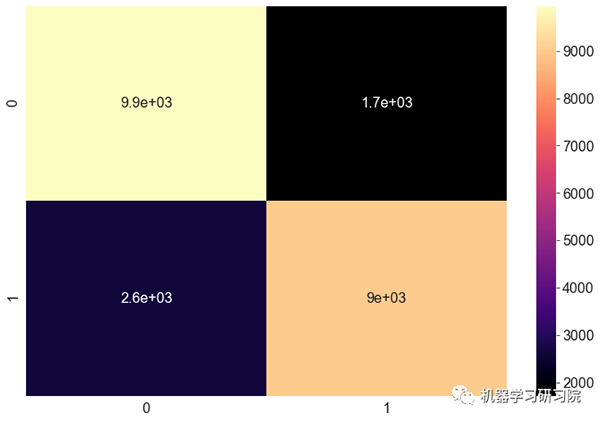
分类报告:
分类报告是一种性能评估指标。它用于显示训练分类模型的准确率、召回率、F1 分数和支持度。
ROC_AUC score is 0.8804566893762799
accuracy score is : 0.8127466117687425
Precision is : 0.8397949673811743
Recall is: 0.7729456167438669
F1 Score is : 0.8049848132928354
classification report
precision recall f1-score support
0.0 0.79 0.85 0.82 11658
1.0 0.84 0.77 0.80 11658
accuracy 0.81 23316
macro avg 0.81 0.81 0.81 23316
weighted avg 0.81 0.81 0.81 23316- 1.
- 2.
- 3.
- 4.
- 5.
- 6.
- 7.
- 8.
- 9.
- 10.
- 11.
- 12.
AUC_ROC 曲线:
AUC_ROC 曲线 是在各种阈值设置下对分类问题的性能测量。ROC 是概率曲线,AUC 表示可分离性的程度或度量。它告诉模型能够在多大程度上区分类别。
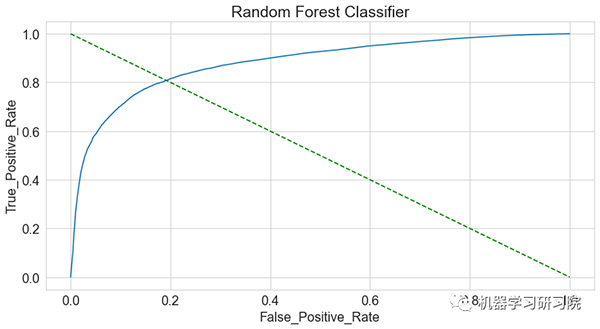
观察得到:
- 为模型找到了不错的准确度分数(~0.86) 、精确度和召回率。
- AUC_ROC 曲线显示了测试值和预测值之间的匹配良好。
- 总的来说,这表明该模型非常适合预测。
XGBoost 分类器
为了进一步提高预测准确性和 ROC_AUC 分数,尝试使用XGBoost 分类器, 因为它本质上非常适合不平衡分类问题。
由于本文篇幅较长,这里省略代码部分,仅显示输出结果。
对于 XGBoost 分类器预测结果,获得较好的 ROC_AUC 分数 (约0.87)。同样,为了查看模型性能可视化不同的性能指标。
混淆矩阵:
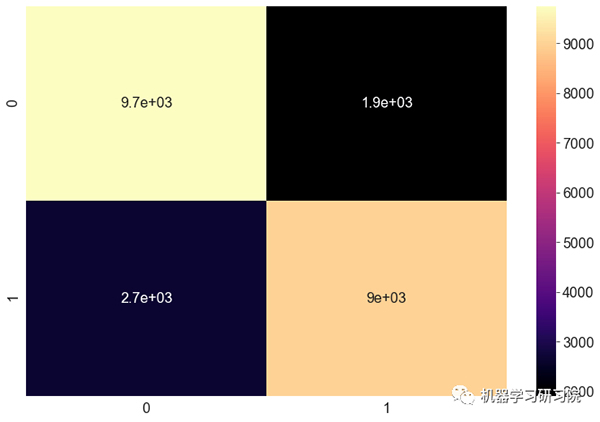
分类报告:
ROC_AUC score is 0.8706238059470456
accuracy score is : 0.8033968090581575
Precision is : 0.8246741325500275
Recall is: 0.7706296105678504
F1 Score is : 0.7967364313586378
classification report
precision recall f1-score support
0.0 0.78 0.84 0.81 11658
1.0 0.82 0.77 0.80 11658
accuracy 0.80 23316
macro avg 0.80 0.80 0.80 23316
weighted avg 0.80 0.80 0.80 23316- 1.
- 2.
- 3.
- 4.
- 5.
- 6.
- 7.
- 8.
- 9.
- 10.
- 11.
- 12.
AUC_ROC 曲线:
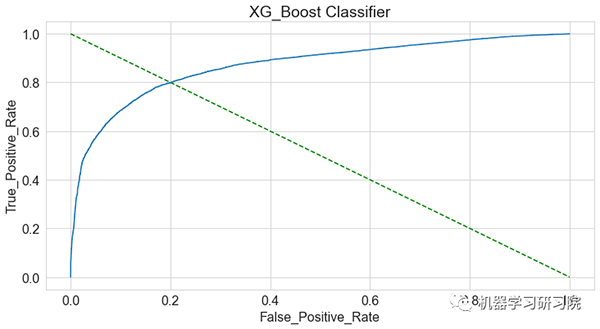
观察得到:
- 绘制的 AUC_ROC 曲线显示测试数据与预测值之间的匹配良好。
- 发现ROC分数的最大值是0.87。
- 然而 XGBoost 在测试数据的 AUC 分数下降到 约0.86,由此可见出现过度拟合问题。
LGBM 分类模型
为了避免数据集中过度拟合的问题,尝试使用分层 K折交叉验证器并使用 LGBM模型来预测基于分类的概率。
- 分层 K 折交叉验证器它提供训练/测试索引以将数据拆分为训练/测试集。这个交叉验证对象是 K-Fold 的一种变体,它返回分层折叠。通过保留每个类别的样本百分比来进行折叠。
在这里,我使用了 10 个具有不同参数的分层k折交叉验证。
from lightgbm import LGBMClassifier
lgb_params= {'learning_rate': 0.045,
'n_estimators': 10000,
'max_bin': 84,
'num_leaves': 10,
'max_depth': 20,
'reg_alpha': 8.457,
'reg_lambda': 6.853,
'subsample': 0.749}
lgb_model = cross_val(xc, yc,
LGBMClassifier,
lgb_params)- 1.
- 2.
- 3.
- 4.
- 5.
- 6.
- 7.
- 8.
- 9.
- 10.
- 11.
- 12.
运行LGBM算法后,得到一个不错的 ROC_AUC分数(约0.87)。接下来使用不同指标检验模型性能。
混淆矩阵:
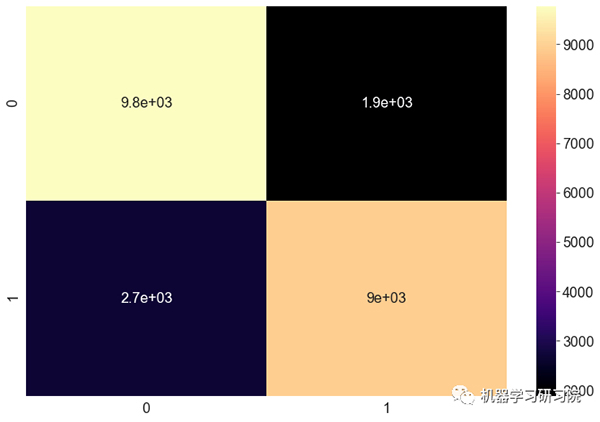
分类报告:
ROC_AUC score is 0.8706238059470456
accuracy score is : 0.8030965860353405
Precision is : 0.8258784469242829
Recall is: 0.7681420483787956
F1 Score is : 0.7959646237944981
classification report
precision recall f1-score support
0.0 0.78 0.84 0.81 11658
1.0 0.83 0.77 0.80 11658
accuracy 0.80 23316
macro avg 0.80 0.80 0.80 23316
weighted avg 0.80 0.80 0.80 23316- 1.
- 2.
- 3.
- 4.
- 5.
- 6.
- 7.
- 8.
- 9.
- 10.
- 11.
- 12.
AUC_ROC 曲线:
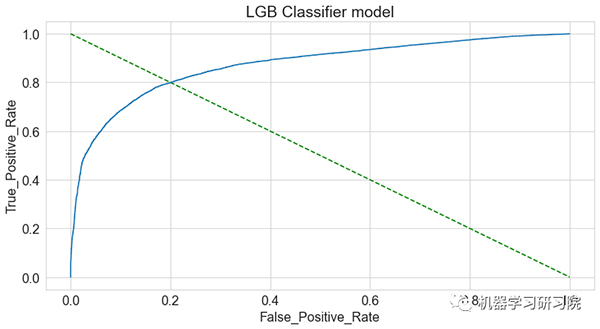
观察得到:
- 该模型在测试集上表现较好,AUC得分为约0.871。
- 这样有效地解决了模型过拟合问题。
- 根据可视化的性能指标,即AUC_ROC曲线,显示了测试值和预测值之间的匹配良好。
模型预测
预测数据集准备
① 可以删除不相关且对数据没有影响的列,例如 "source" 列。
df_3 = df_testdf_3.drop(
columns=["source"],
inplace=True)
df_3.head()- 1.
- 2.
- 3.
- 4.

② 从测试数据集中删除目标变量。
xc_pred = df_3.drop(columns=['Is_Lead',"ID"])- 1.
③ 使用StandardScaler对 x 的值进行数据标准化,得到呈正态分布的数据集。
sc = StandardScaler()
df_xc_pred = pd.DataFrame(
sc.fit_transform(xc_pred),
columns=xc_pred.columns)
Lead_pred_xg=clf2.predict_proba(df_xc_pred)[:,1]
Lead_pred_lgb=lgb_model.predict_proba(df_xc_pred)[:,1]
Lead_pred_rf=rf_clf.predict_proba(df_xc_pred)[:,1]
print(lead_pred_xg,lead_pred_lgb,lead_pred_rf)
[0.09673516 0.9428428 0.12728807 ...
0.31698707 0.1821623 0.17593904]
[0.14278614 0.94357392 0.13603912 ...
0.22251432 0.24186564 0.16873483]
[0.17 0.97 0.09 ...
0.5 0.09 0.15]- 1.
- 2.
- 3.
- 4.
- 5.
- 6.
- 7.
- 8.
- 9.
- 10.
- 11.
- 12.
- 13.
- 14.
④ 为潜在客户预测创建DataFrame数据框。
#用于潜在客户预测的数据框Lead_pred_lgb= pd.DataFrame(lead_pred_lgb,columns=["Is_Lead"])Lead_pred_xg= pd.DataFrame(lead_pred_xg,columns=["Is_Lead"])Lead_pred_rf= pd.DataFrame(lead_pred_rf,columns=["Is_Lead"])- 1.
⑤ 将"ID"和预测保存到所有模型的 csv 文件中。
#为XG模型保存ID和预测到csv文件
df_pred_xg=pd.concat([df_test["ID"],lead_pred_xg],axis=1,ignore_index=True)
df_pred_xg.columns = ["ID","Is_Lead"]
print(df_pred_xg.head())
df_pred_xg.to_csv("Credit_Card_Lead_Predictions_final_xg.csv",index=False)
#为LGB模型保存ID和预测到csv文件
df_pred_lgb=pd.concat([df_test["ID"],lead_pred_lgb],axis=1,ignore_index=True)
df_pred_lgb.columns = ["ID","Is_Lead"]
print(df_pred_lgb.head())
df_pred_lgb.to_csv("Credit_Card_Lead_Predictions_final_lgb.csv",index=False)
#为RF模型保存ID和预测到csv文件
df_pred_rf=pd.concat([df_test["ID"],lead_pred_rf],axis=1,ignore_index=True)
df_pred_rf.columns = ["ID","Is_Lead"]
print(df_pred_rf.head())
df_pred_rf.to_csv("Credit_Card_Lead_Predictions_final_rf.csv",index=False)- 1.
- 2.
- 3.
- 4.
- 5.
- 6.
- 7.
- 8.
- 9.
- 10.
- 11.
- 12.
- 13.
- 14.
- 15.
⑥ LGBM 模型输出。
ID Is_Lead
0 VBENBARO 0.096735
1 CCMEWNKY 0.942843
2 VK3KGA9M 0.127288
3 TT8RPZVC 0.052260
4 SHQZEYTZ 0.057762
ID Is_Lead
0 VBENBARO 0.142786
1 CCMEWNKY 0.943574
2 VK3KGA9M 0.136039
3 TT8RPZVC 0.084144
4 SHQZEYTZ 0.055887
ID Is_Lead
0 VBENBARO 0.17
1 CCMEWNKY 0.97
2 VK3KGA9M 0.09
3 TT8RPZVC 0.12
4 SHQZEYTZ 0.09- 1.
- 2.
- 3.
- 4.
- 5.
- 6.
- 7.
- 8.
- 9.
- 10.
- 11.
- 12.
- 13.
- 14.
- 15.
- 16.
- 17.
- 18.
因此,LGBM 被选为最终模型,因为该模型在训练集和测试集上均具有最高及最一致的 AUC 分数。
预测模型存储
这里使用joblib库保存模型。
import joblib
# 将模型保存为文件中的pickle
joblib.dump(lgb_model,
'lgb_model.pkl')
['lgb_model.pkl']- 1.
- 2.
- 3.
- 4.
- 5.
写在最后
数据包含分类数据和数值数据。将类别转换为数值数据以进行EDA分析。
还进行了数据可视化分析,并得到到以下情况:
- 在过去3个月里,与企业家相比,活跃客户更多地来自工薪阶层、个体经营者和其他人群。
- 目标变量是不平衡的,需要进行样本平衡处理以有效的建模。本案例中利用欠采样技术实现数据集的平衡。
随机森林分类器
- 发现随机森林模型的AUC得分最高(约0.91)。
- 然而,随机森林模型在测试数据集上的AUC得分只有约0.85。
XGBoost分类器
- 为了进一步提高准确率,我们使用 XGBoost 模型,通过训练数据发现AUC得分为0.87。
- 然而,XGBoost 模型在测试数据集上的 AUC 评分下降到约0.86,存在过拟合问题。
分层交叉验证的LGBM分类器
- 为解决过拟合问题,采用10折交叉验证的LGBM模型,在训练数据上AUC得分为0.874。
- 该模型在测试数据上表现同样良好,AUC 得分约 0.871。
- 因此,我们选择LGBM模型作为最终模型,因为它在训练集和测试集上AUC得分最高,且最一致的。




























